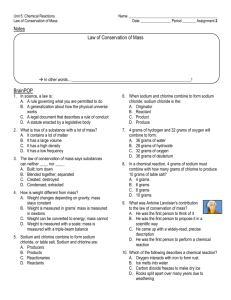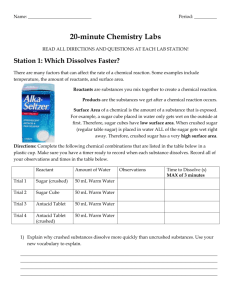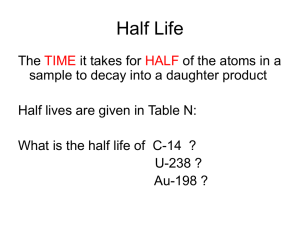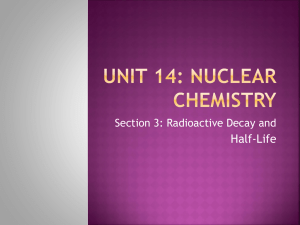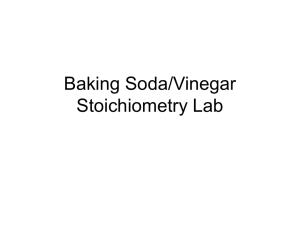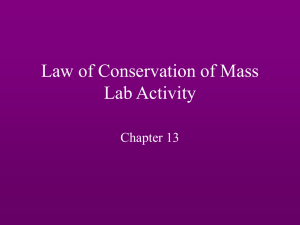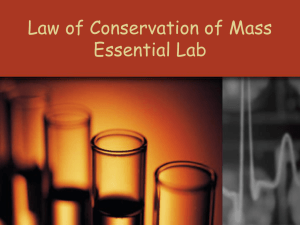baking soda and vinegar power point baking_soda_and_vinegar_3
advertisement
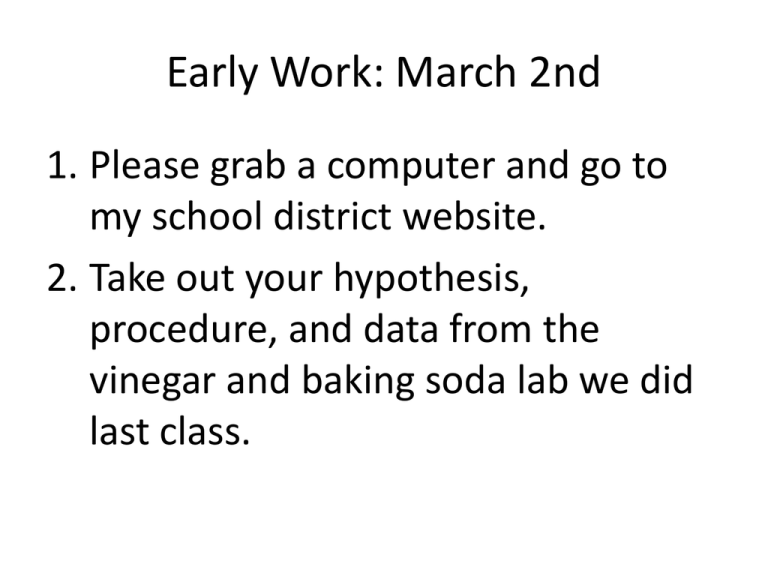
Early Work: March 2nd 1. Please grab a computer and go to my school district website. 2. Take out your hypothesis, procedure, and data from the vinegar and baking soda lab we did last class. Chemical reaction CH3COOH + NaHCO3 Acetic Acid and Sodium Bicarbonate CH3COONa + H2O + CO2 Sodium Acetate and Water and Carbon Dioxide •Does the total mass of the matter involved in the reaction change? •Can matter be created or destroyed during a chemical reaction? Agenda: March 2nd • Baking soda and vinegar reaction in depth • Check crystal formation project • Revise MSP practice • Jordan and Isaiah watch a chemical reaction between baking soda (NaHCO3) and vinegar (CH3COOH). • They noticed that combining the two reactants produced bubbles and they guessed that it was a gas being produced in the reaction. • They wondered if there was a relationship between the amount of baking soda and vinegar and the amount of gas produced in the reaction. • Write a testable question based on their observations. • Jordan and Isaiah decided to investigate the following question: • What is the perfect ratio of volumes of baking soda and vinegar that will fill a ziplock bag to capacity without bursting the bag open? • What would be the variable you might use in the lab? • Discuss with a neighbor your hypothesis based on the question above. • Write a hypothesis and procedure and carry out the experiment. • Materials: – Ziplock bag (needs to cleaned after every trial) – Baking soda – Vinegar – Graduated cylinder – Scale – Measuring scoop – Pipette – Paper towels • Be sure to record data in your cornell notes. • Once you have collected data, write a conclusion. Amount vinegar Amount Baking soda Result (burst, did not inflate) 100 ml 100 100ml 100 100 100ml 100ml 100 ml 100 ml 100 ml 40ml 60ml 70ml 100ml 40ml 50ml 60ml 50ml 70ml 85 80 80 50 ml 60 Ml 90 Ml 100 Ml 7.5 grams 8 grams 8.5 grams 9 grams 6 grams 20 grams 5grams 15 grams 6 grams 3.8 grams 7grams 10grams 20grams 42grams 12.9g 22.9g 32.9gr 3grams 10grams 30g 30 30 10 Grams 40 Grams 60 Grams 100 Grams inflated Burst Burst Burst Inflated, not pop P0PPED ! Inflated!! :D Inflated Inflated:D Inflated All inflated. Almost burst 1.3 gas was product 1.6 gas product popped inflated Inflated Inflated 1 Same Exploded 4grams 1 gram 0.5 G 0.6 G 0.8 G POPPED ! O: Write a conclusion • Write a conclusion in the summary of your cornell notes. – Answer the testable question: What is the perfect ratio of volumes of baking soda and vinegar that will fill a ziplock bag to capacity without bursting the bag open? – Use supporting data. – Make a mathematical comparison. – Connect experiment to real world scenario. • Go to Mr. Baur’s website and write final drafts of hypothesis, procedure, and conclusion. Select a chemical, find a partner, get a computer. • • • • • • • Alum: AlKSO4 Borax: NaBO7 Table salt: NaCl Copper sulfate: CuSO4 Sugar (sucrose): C12H22O11 Epsom salts: MgSO4 Baking soda: sodium bicarbonate: CHNaO3 Crystal chemical research • Common name and chemical formula • Common uses • Density • Melting and boiling pts • Solubility in water at 20 oC • Color • 3-D Arrangement of compound • Safety concerns http://webmineral.com/ http://www.chemspider.com/ Procedure 1. On a piece of tape, label a glass dish with the name of the chemical you will be using. 2. Pour 200 mL of hot water (80 degrees Celsius) into the dish. 3. Weigh 50 grams of chemical into a plastic cup. 4. Add chemical to hot water until dissolved. Stir until dissolved. 5. Find the mass of the remaining chemical in the plastic cup and subtract it from 50 grams to find the amount of chemical you added. Tell this number to Mr. Baur. 6. Wrap a pipe cleaner or string around a pencil and place it on the top of the dish. 7. Crystals should form in the next few days as the water evaporates.

